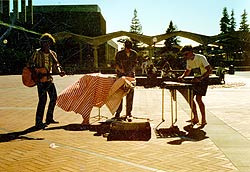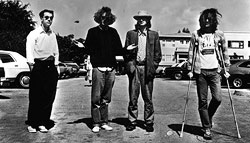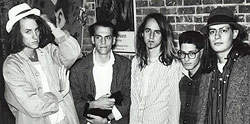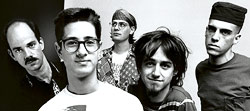Official History
 1986 1986
June: Shiurba, Cooper and Bonerz meet one summer day over at Eric's
house and rehearse together for the first time, learning ten songs (mostly
covers with a few Ice Nine tunes thrown in). That same afternoon they
play their first show on UC Berkeley campus, under the name LARGE
MEAL. The group is all acoustic (guitar, marimba, and a drumkit
consisting of a snare drum and ride cymbal with a sheet over the top
to keep it from drowning out the other instruments). A passerby informs
them that they'll be changing the name soon. At the same time Bonerz
and Shiurba develop an experimental/electronic duo called PAIN &
DISCOMFORT which mostly meets for private recordings.
July: After a few shows Large Meal officially changes its name, but
no one can decide on exactly what the name will be, although the 3 members
all agree that it will have the word ESKIMO in it. The band
continues to perform on Berkeley sidewalks changing its name daily (First
Eskimo On The Moon, Eskimo Dentist Chair, Eskimohammed Ali, Eskimo Clearwater
Revival, etc.)
 September:
Greg Walker returns and the band becomes a quartet. The band continues
its street performances and plays a few parties, sometimes using minimal
amplification. September:
Greg Walker returns and the band becomes a quartet. The band continues
its street performances and plays a few parties, sometimes using minimal
amplification.
December: The band somehow manages to get a show at the DNA Lounge and
makes its first on stage appearance on Dec 18. This was the set list:
Sesame Street/ Thin Shoulders Shaking/ Outdoor Miner/ Be My Valentine/
Sea Of Love/ Pocketful Of Gold/ Perfect/ Mary Tyler Moore/ Magic Carpet
Ride/ Born To Be Wild/ Rock Me Amadeus/ Chicken/ Coffee Table Blues.
1987
January-June: The band continues to play on the streets, and puts together
a few more club gigs, including two infamous gigs at Club 181 with satirist/comedian
Stoney Burke. Bands like The Muskrats, Blue Movie, Bardo and The Furies
help out giving Eskimo opening slots and lots of encouragement. The
band develops its semi-amplified sound and Walker begins to play more
trombone (as much as guitar).
 July-December:
Mark Landsman returns and joins the band, allowing the introduction
of electric guitar, and the band takes on a whole new more powerful
sound. The cover songs are mostly phased out and replaced with original
tunes. The band records with Klaus Fluoride, and goes on a tour of the
Pacific Northwest in two Japanese compact cars, during which they make
the acquaintence of bassist Steve Lew, who will join the band, just
8 short years later. July-December:
Mark Landsman returns and joins the band, allowing the introduction
of electric guitar, and the band takes on a whole new more powerful
sound. The cover songs are mostly phased out and replaced with original
tunes. The band records with Klaus Fluoride, and goes on a tour of the
Pacific Northwest in two Japanese compact cars, during which they make
the acquaintence of bassist Steve Lew, who will join the band, just
8 short years later.
1988
This was the big developmental year for the "Early" line-up. The material
was honed, crappy songs were discarded, lots of shows, touring, etc.
By September plans were in the works for an album, and in September
the band recorded a new demo, which would be the first half of the first
album Jack.
1989
When the demo turned up little or no label interest, Eskimo decided
to go for it alone. The remaining tracks were recorded at Dancing Dog
and the first album was put together. Money was raised to help fund
the pressing in an ingenius fundraiser concert thought up by Bruce Brugmann
(publisher of the Bay Guardian) where the price of admission
included a voucher for the record, redeemable months later. The group
was facing a major trauma however, as Greg Walker had announced that
he would leave the band to pursue a career in the film industry. By
some incredible stroke of luck Eskimo crossed paths with one of the
few people on the planet who could have and would have been able to
replace Walker, former Wrestling Worms trombonist, Tom Yoder. So began
what is usually referred to as the "Classic" line-up.
1990
 The
fruits of Eskimo's years of labor had ripened long enough, and finally
plopped off in the form of Jack. The band hit the road playing
lots of shows all over the west coast and generating a greater following
than it had known. In between shaking the distributors down for money,
the band developed a strange collection of short pieces to contribute
to a mostly spoken word CD, We Magazine: Issue 14, which was
recorded over the summer. During this era, the band experimented with
all improvisational sets, and decided quickly thereafter to devote its
energy toward something more productive, namely writing new songs, a
lot of really short new songs. The
fruits of Eskimo's years of labor had ripened long enough, and finally
plopped off in the form of Jack. The band hit the road playing
lots of shows all over the west coast and generating a greater following
than it had known. In between shaking the distributors down for money,
the band developed a strange collection of short pieces to contribute
to a mostly spoken word CD, We Magazine: Issue 14, which was
recorded over the summer. During this era, the band experimented with
all improvisational sets, and decided quickly thereafter to devote its
energy toward something more productive, namely writing new songs, a
lot of really short new songs.
1991
It was during 1991 that the material that would comprise the second
Eskimo album, Der Shrimpkin was brought into being. Yoder had
become an integral part of the group by this time, and the music began
to take on a more relaxed, less serious feel than was prevalent on Jack.
The live shows from this era were looser, more energetic and the music
that was being written reflects this. When the group songwriting process
was distilled into the anthemic "Electric Acid Pancake House" it was
clear that the second album was complete and in the fall Eskimo began
recording with no idea as to how it would ever be put out.
1992
No sooner had the band put the finishing touches on Der Shrimpkin
than Mark Landsman announced that he would leave the band to pursue
graduate studies in history in New York. The band members were shocked,
yes, shocked and stunned. The idea of replacing Landsman was tossed
around but eventually dropped when Bonerz announced that he too would
be leaving the band to pursue a career as a clothing industry magnate
in Los Angeles. To the dismay of its fans, the relief of its detractors
and the general indifference of the population at large, Eskimo called
it quits in the back room of the El Rio one night in April. David threw
himself into his painting and John and Tom began planning a new project
with bassist Steve Lew, eventually this would become Ebola Soup.
1993
In January the "Classic" line-up reformed for the first in a shamelessly
extended series of reunions. The excuse for this first one was fairly
legitimate, however, namely the (cassette only) release of the 2nd album
The Further Adventures Of Der Shrimpkin. This was the only Eskimo
activity for the year, a bright spot in what most fans refer to as the
"Dark Ages".
1994
In January the "Classic" line-up reformed again for another pair of
Bay Area shows, for no reason other than the fun of it. Another rather
less bright spot in the "Dark Ages" followed. In the fall of 1994, however,
something quite unusual happened. Shiurba noticed an interview with
Primus bassist Les Claypool in BAM in which he stated that
he would love to put out an Eskimo record on his new label, Prawn Song.
After a few phone calls, Eskimo was on their way to a record deal that
would finally unearth their nearly forgotten 2nd album.
1995
After much litigation, it really came together, Prawn Song had farted
out a little cloud of manna from heaven, and in March 1995, Der Shrimpkin
got delayed again, but the band got back together anyway to play a few
shows including one at the Fillmore opening for Primus. In April the
record did actually come out and the band reformed for a West Coast
tour with bassist Steve Lew filling in for Mark Landsman. When a national
tour opening for Primus fell through (they went with Helmet instead),
Eskimo set up its own tour. Unfortunately, Eric Bonerz had to back out
and the band turned to drummer Andrew Borger (who just happened to be
willing to commit, at the last minute, to a month on the road for virtually
no money) to fill his shoes for the tour. Well they say being on the
road does things to you, screws with your head. Maybe that's true. By
the time the "tag-team" Eskimo lineup returned from this trip, they
had sworn vows anew, made commitments, signed charters: a new Eskimo
was born. This Eskimo may come to be known as the "Late" lineup or perhaps
the "New" lineup, only time will tell. The past will be the past but
this group will go on, meeting in stinky garages and weird insulated
rooms to practice and perfect their bizarre language of music. 1995
ended with a short jaunt to the Pacific Northwest.
1996
For the first half of the year, the new incarnation of Eskimo went forth
into the world and did not much. The big things to talk about were the
facts that one, an East Bay Express critic named Sam Hurwitt chose "Der
Shrimpkin" as one of the best CDs of '95, and two, Eskimo's version
of "Happy Home" was included on a compilation CD of Residents covers,
put together by Vaccination Records. There was a record release party
for the CD in which Eric Bonerz (re)joined the band for a set of all
Residents/Snakefinger covers. By the time summer rolled around the boys
were feeling a bit nostalgic, harking back to their glory days, and
realizing that TEN YEARS had gone by since they launched the Eskimo
ark onto the unsteady seas, they decided to celebrate. On September
10, The Eskimo Ten Year Reunion Show took place at, you guessed it,
El Rio. The band recreated it's evolution right on stage, with each
of the incarnations (original members, of course) recreating the big
hits and long forgotten ditties of yesteryear. They also insisted that
Blue Movie do a reunion show, in between sets, and that Idiot Flesh
create a new puppet show for the occasion. Again the year was rounded
out by a short jaunt to the Northwest.
1997
 On
paper, 1997 looks like a rather slow year for the feather-haired five,
but in spite of the fact that they played live only five times, they
were quite busy lads. The year started with a bang, a new project in
uncharted territory -- Jeannie Kahaney and Heidi Arnesen asked the band
to score their feature length film, "Some
Prefer Cake". The band got busy and by February were in the studio
recording the music with Myles Boisen behind the controls. The film
premiered in June, and the band assembled the music for a CD to be released
by Vaccination Records. In spite of this and the other wonderful things
about 1997, the present line-up would not see the year's end. In august,
Steve Lew shocked the world when he announced he would leave the band
to pursue his studies in entomology (having long ago mastered etymology).
The band was shocked, yes shocked, and stunned. They began the painful
process of auditioning new bass players, and ended up with too many
qualified, personable possibilities. Alas, they had to choose, and choose
they did. In October, a chap by the name of Matt Small became the third
bassist for Eskimo. His prodigious talents were unleashed on the world
in December when he made his debut with the band. As the year wound
to a close the boys were eagerly awaiting the arrival of their new soundtrack
CD, and planning the details of their next recording project, a new
full-length CD of the songs they had toiled over for the past two years. On
paper, 1997 looks like a rather slow year for the feather-haired five,
but in spite of the fact that they played live only five times, they
were quite busy lads. The year started with a bang, a new project in
uncharted territory -- Jeannie Kahaney and Heidi Arnesen asked the band
to score their feature length film, "Some
Prefer Cake". The band got busy and by February were in the studio
recording the music with Myles Boisen behind the controls. The film
premiered in June, and the band assembled the music for a CD to be released
by Vaccination Records. In spite of this and the other wonderful things
about 1997, the present line-up would not see the year's end. In august,
Steve Lew shocked the world when he announced he would leave the band
to pursue his studies in entomology (having long ago mastered etymology).
The band was shocked, yes shocked, and stunned. They began the painful
process of auditioning new bass players, and ended up with too many
qualified, personable possibilities. Alas, they had to choose, and choose
they did. In October, a chap by the name of Matt Small became the third
bassist for Eskimo. His prodigious talents were unleashed on the world
in December when he made his debut with the band. As the year wound
to a close the boys were eagerly awaiting the arrival of their new soundtrack
CD, and planning the details of their next recording project, a new
full-length CD of the songs they had toiled over for the past two years.
1998 to 2001
The band made a valliant attempt to record its recent material. This
effort ran afoul of limited resources and crappy home-recording technology.
The project was ultimately aborted. A reunion retreat took place in
the summer of 2001, at Camp Peter Bonerz, to mark the fifteenth anniversary
of Eskimo's first show. Three new songs were recorded. Would you like
to hear them? Please visit the MP3 page.
2002 to 2014
But wait! The abandoned recording project was found in a closet and
revived and COMPLETED! It's called Utica
and it is what it is!
If you took the time to read this entire history, we would like to reward
you for your trouble. Who the hell are you? Contact
us. |

